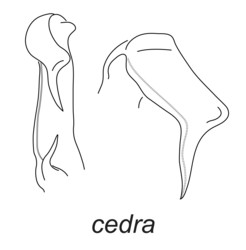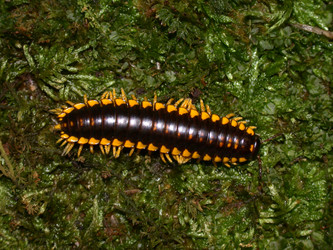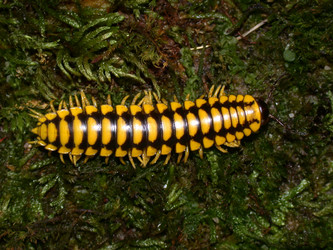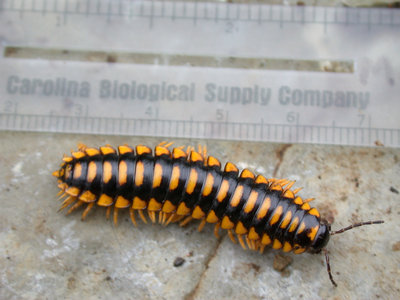Brachoria cedra
The Cedar Glade Mimic Millipede
Paul MarekCharacteristics
Brachoria cedra individuals are about 37.5 mm long and 9.9 mm wide (females 38.7 mm X 10.2 mm). Color: 3-spotted yellow (shown above) or orange (rare); and 2-spotted yellow (rare).


Brachoria cedra genitalia - left male gonopodal acropodite (with setae removed): (Left) medial view and (Right) magnified apical view. © Paul Marek

Brachoria cedra, 3-spotted orange color morph. © Paul Marek


Brachoria cedra, 3-spotted yellow color morph with faint medial metatergal spots. © Paul Marek


Brachoria cedra, 3-spotted yellow color morph (note the variation in spot shape and hue between color morphs, in particular this specimen and the other 3-spotted color morph at the top). © Paul Marek
Habitat
Brachoria cedra was previously only known from the cedar glades around Jonesville in Lee County, Virginia; however, other localities in Lee County have recently been discovered, including a disjunct population around High Knob in the tulip and maple deciduous forest. All specimens were collected during the day in either cedar forests (Juniperus virginiana) or mixed mesophytic deciduous forests. At the cedar glade localities, individuals were found beneath layers of decomposing cedar leaves. Brachoria cedra normally occurred beneath cedar duff on the plate-like dolomitic limestone. One other xystodesmid encountered sympatrically at this locality is Apheloria virginiensis corrugata which has a strong mimetic resemblance with B. cedra. At the other localities, B. cedra was found beneath decomposing leaves of broadleaf species like maple, tulip, and oak. Note: Individuals of B. cedra may easily be confused in the field with Apheloria virginiensis corrugata, B. dentata, B. insolita, B. mendota, B. sheari and B. hoffmani due to similarity in color patterns (around High Knob all of these species, except B. sheari and B. mendota, can be found as mimics) and overlap in distribution.Distribution
Known from four areas in southwestern Virginia from Edd’s Mill in southwestern Lee County, Virginia, northeast through the cedar glades and Lovelady Gap, to the highlands around High Knob in Norton City and Wise Counties, VA. Brachoria cedra co-occurs with B. dentata, B. insolita, B. mendota, B. sheari and B. hoffmani forming a component of a Müllerian mimicry ring with them.Conservation status
Brachoria cedra is threatened by habitat loss due to agriculture (especially growing demand for paper products), coal mining, development, and the invasion of exotic species.References
Marek P.E. 2010. A revision of the Appalachian millipede genus Brachoria Chamberlin, 1939 (Polydesmida: Xystodesmidae: Apheloriini). Zool. J. Linn. Soc. 159: 817-889.
Keeton W.T. 1959. A revision of the millipede genus Brachoria (Polydesmida: Xystodesmidae) Proc. US Nat. Mus. 109: 1-58.
Keeton WT. 1965. Descriptions of three new species of Brachoria, with notes on established species (Diplopoda, Polydesmida, Xystodesmidae). Proc. Biol. Soc. Wash. 78: 225-240.
Hoffman RL. 1971. Millipeds of the genus Brachoria from southwestern Virginia (Polydesmida: Xystodesmidae). Rad. Rev. 25: 83-99.
Hoffman R.L. 1999. Checklist of the millipeds of North and Middle America. Virginia Museum of Natural History Special Publication. No. 8. Martinsville: Virginia Museum of Natural History.
Title Illustrations

| Scientific Name | Brachoria cedra |
|---|---|
| Location | USA, Virginia, Lee Co. |
| Reference | Marek P.E. 2010. A revision of the Appalachian millipede genus Brachoria Chamberlin, 1939 (Polydesmida: Xystodesmidae: Apheloriini). Zool. J. Linn. Soc. 159: 817-889. |
| Specimen Condition | Live Specimen |
| Sex | m |
| Life Cycle Stage | adult |
| View | dorsal |
| Collection | FMNH |
| Collector | Paul Marek |
| Image Use |
 This media file is licensed under the Creative Commons Attribution-NonCommercial License - Version 3.0. This media file is licensed under the Creative Commons Attribution-NonCommercial License - Version 3.0.
|
| Copyright |
© Paul Marek

|
About This Page
Work on the millipede Tree of Life pages was supported by a U.S. National Science Foundation Doctoral Dissertation Improvement Grant to Paul Marek and Jason Bond (DEB 0607996) and a Partnerships for Enhancing Expertise in Taxonomy Grant to Petra Sierwald, Jason Bond, and William Shear (DEB 0529715).
Paul Marek

Virginia Polytechnic Institute and State University
Correspondence regarding this page should be directed to Paul Marek at
brachoria@gmail.com
Page copyright © 2010 Paul Marek
 Page: Tree of Life
Brachoria cedra . The Cedar Glade Mimic Millipede.
Authored by
Paul Marek.
The TEXT of this page is licensed under the
Creative Commons Attribution-NonCommercial License - Version 3.0. Note that images and other media
featured on this page are each governed by their own license, and they may or may not be available
for reuse. Click on an image or a media link to access the media data window, which provides the
relevant licensing information. For the general terms and conditions of ToL material reuse and
redistribution, please see the Tree of Life Copyright
Policies.
Page: Tree of Life
Brachoria cedra . The Cedar Glade Mimic Millipede.
Authored by
Paul Marek.
The TEXT of this page is licensed under the
Creative Commons Attribution-NonCommercial License - Version 3.0. Note that images and other media
featured on this page are each governed by their own license, and they may or may not be available
for reuse. Click on an image or a media link to access the media data window, which provides the
relevant licensing information. For the general terms and conditions of ToL material reuse and
redistribution, please see the Tree of Life Copyright
Policies.
- First online 16 September 2010
- Content changed 16 September 2010
Citing this page:
Marek, Paul. 2010. Brachoria cedra . The Cedar Glade Mimic Millipede. Version 16 September 2010 (under construction). http://tolweb.org/Brachoria_cedra/144211/2010.09.16 in The Tree of Life Web Project, http://tolweb.org/








 Go to quick links
Go to quick search
Go to navigation for this section of the ToL site
Go to detailed links for the ToL site
Go to quick links
Go to quick search
Go to navigation for this section of the ToL site
Go to detailed links for the ToL site